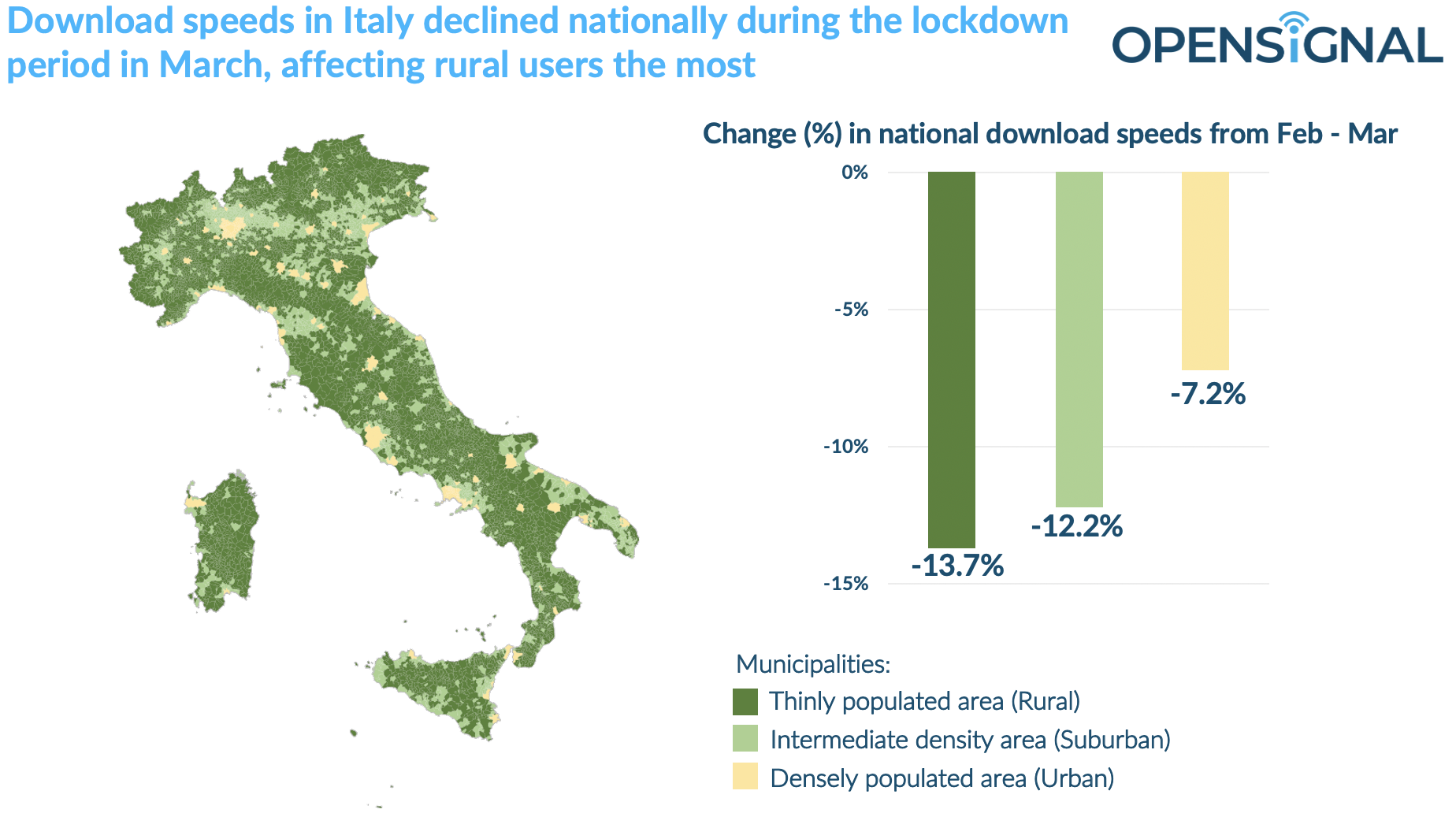As Italy imposed restrictions last month owing to the COVID-19 pandemic, operators have reported a dramatic surge in mobile data usage which has affected the mobile network experience of users across the country.
Overall, Italy’s mobile operators have offered a highly resilient service, especially to urban users. In March, Opensignal found that the download speeds experienced by smartphone users in Italy decreased on average by 7.2% in urban areas, much less than in suburban or rural areas where speeds fell by 12.2% or 13.7% respectively.

Opensignal analyzed the smartphone users’ Download Speed Experience in the urban and rural areas of Italy for the period starting on January 1 and ending on March 31. We have used the Degree of urbanization classification adopted by Istituto Nazionale di Statistica (Istat), which classifies all Italian municipalities into three types of areas: thinly populated (rural areas); intermediate density (towns, suburbs and small urban areas), and densely populated (cities and large urban areas).
On examining the mobile experience across Italy’s five macro-regions — Centre, Islands, North-East, North-West, and South — we found that the average Download Speed Experience in the month of February did not vary significantly compared to that in the month of January in any of the three types of area(urban, suburban and rural).
Conversely, in the month of March, when the government had imposed country-wide restrictions, we observed notable differences with a significant drop in download speeds compared to that in the previous month, across all regions. And this decline was more pronounced in rural areas. 
In the urban areas, users in the Islands region saw the largest decrease of 12.5% as their average download speed fell from 27.6 Mbps to 24.1 Mbps, and the lowest decrease of 2.6% in the North-East, while speeds in the other regions declined by less than 10%. The decline in users' download speed became more pronounced as we moved away from the urban centers of Italy.
Our suburban users saw their speeds reduce by more than 10% in at least four out of five regions, with the highest decline seen in the Islands region — a decrease of 13.4% from 23.1 Mbps to 20 Mbps. We saw a similar magnitude of downturn in the Southern region — a drop of 13.2% from 22.2 Mbps to 19.2 Mbps — and the North-West region where download speeds reduced by 12.6% from 27.1 Mbps to 23.7 Mbps.
Meanwhile, our rural users in Italy saw their download speeds deteriorate more, with those in the Islands region experiencing the largest reduction of 22.3%, as the speeds plunged from 24.6 Mbps to 19.1 Mbps. The second largest decline of 15.1% was recorded in the Centre region, where rural speeds fell from 21.5 Mbps to 18.2 Mbps. We saw a similar decline in the Southern region’s rural areas — a 14.8% decline from 23 Mbps to 19.6 Mbps.

But why are the speeds contracting in Italy? Although, it is obvious that mobile data consumption is increasing which is leading to more congested networks, there are a multitude of other factors affecting the experience. One of these is the change in location of mobile usage, as thousands of Italians working in cities have moved out to their second residences or hometowns in the suburbs or rural areas to avoid being quarantined in the city. This means that users are spending more time in locations where the network infrastructure was not meant to support large traffic loads.
Also, operators have reduced or even removed the data limits on their mobile services, or cut the price of packages, to help customers stay connected during this crisis. Hence, consumers are now able to consume more data than usual without hindrance. Additionally, with shifts in users' behaviour during the quarantine, speeds have started falling during the non-peak hours, bringing down overall speeds, as seen in our recent analysis.
With all these factors coming into play, the mobile networks experienced greater usage and increased mobile congestion. And despite these drops in download speeds, Italian operators have provided resilient services to their mobile users in this unprecedented situation, as they continue to experience decent download speeds — between 18.2 Mbps to 24.3 Mbps in rural areas, 19.2 Mbps to 25.9 Mbps in suburban areas and 20.5 Mbps to 31.7 Mbps in urban areas.
Opensignal Limited retains ownership of this insight including all intellectual property rights, data, content, graphs & analysis. Reports and insights produced by Opensignal Limited may not be quoted, reproduced, distributed, published for any commercial purpose (including use in advertisements or other promotional content) without prior written consent. Journalists are encouraged to quote information included in Opensignal reports and insights provided they include clear source attribution. For more information, contact [email protected].
